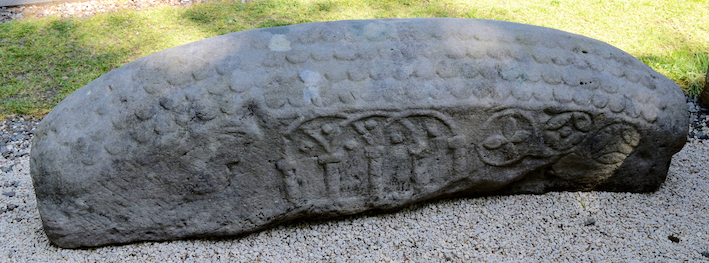Vikings on Loch Lomond
Not as daft as it first seems, Loch Lomond is an INLAND loch, so what were Vikings doing there? More to the point, how did they get there? And aye, they caused bloody mahem.
The Vikings in Strathclyde: The Hidden Heritage project commissioned a report by Dr. Elizabeth Pierce (Glasgow University) to identify any Viking related archaeological evidence in this area brings historical evidence for the Vikings in Central and Western Scotland. Whilst archaeological evidence of Viking activity along the River Clyde and in the west of Scotland is rare, it does exist. This evidence coupled with historical documents provides us with a picture of the area’s Viking heritage. During the year AD 870, the Annals of Ulster (where would historians, professional and otherwise, such as me, be without this?) record that the Viking Kings of Dublin, Ivar and Olaf, laid siege to Dumbarton Rock at the mouth of the River Clyde. After four months, the Vikings succeeded in sacking the stronghold of the Britons and gained access to the early medieval kingdoms inland via Loch Long and Loch Lomond. This is no mean feat by the way. Evidence includes silver arm rings found near Port Glasgow, lead weights and a sword pommel found at Dumbarton Rock, and the Hunterston Brooch (www.nms.ac.uk/hunterstonbrooch.aspx). Vikings settled around Loch Long and Loch Lomond to trade with central Scotland and establish an overland route to the east. Vikings were settling in along the bonnie banks of Loch Lomond. DNA evidence: The lands around Arrochar (Loch Long) and Tarbet belonged to the MacFarlanes from 1225. MacFarlane descendants are currently taking part in a DNA project to trace their ancestry and research to date has identified several DNA patterns common amongst Viking raiders and settlers along Scotland’s west coast. This suggests the Norse settlers intermarried with MacFarlane women. The dynasty of the ancient earls of Lennox has three principal branches, the clans of Lennox, Macfarlane and Leckie. Macfarlane has long been the largest clan it is vital that all of these clans and their respective Septs have one project for their genetic genealogy. MacFarlane (of any of the over 1,530 variant spellings), Leckie, or Lennox (because all these clans sprang from the mormaers and/or earls thereof). This is the official DNA project of the Clan MacFarlane Society, Australia, Inc. (http://clanmacfarlane.org.au) and of Clan MacFarlane Worldwide, Inc. (http://clanmacfarlane.org). See also https://www.familytreedna.com/groups/mac-farlane.
It’s hard to imagine Vikings could have dragged their longships across land from Arrochar to Tarbet! They wouldn’t have to – they carried smaller boats on board their longships, and these are what they’d have dragged. In 1263 – Viking raiders visited Arrochar on Loch Long so they could drag their boats 2 miles overland to Tarbet on Loch Lomond to plunder unprotected settlements around Loch Lomond. A battle may have taken place between the Vikings and the MacFarlanes at that time as there is a burial ground between Arrochar and Tarbet that may include the grave of a Viking leader. The name Tarbet is derived from the gaelic, An Tairbeart, meaning an isthmus. Ballyhennan Burial Ground, the district of Luss, and Arrochar, before Arrochar was disjoined from Luss in the 17th century. Here there are several old tombstones with Gaelic inscriptions. I have made lots of time for this but as with much of Scottish early history, some things can be very hard to find, this Viking trouble is one of these. I hope therefore to stimulate your interest enough that you carry on with this story. The area near Ballyhennan Church in Tarbet is believed to have been the site of a ‘confrontation’ between the MacFarlanes and Haco’s Vikings, though the exact site has not yet been identified. 11th century Viking Hogback Stone. Hogbacks are stone carved Anglo-Scandinavian sculptures from 10th-12th century England. This stone is thought to have dated from the Loch Lomond raid of 1263, when the Vikings had pillaged and settled on the lochside, maybe one Viking that stayed. It was unearthed in 1926 and until very recently had been covered in moss, but now restored. Over to you …
Want to go there? Ask us for an idea of tours and historic sites in and around the area. paul@mcleanscotland.com

